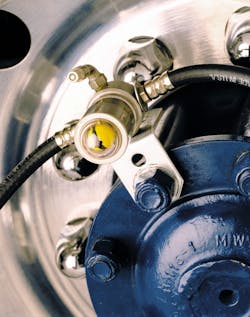It’s clear that proper tire inflation is critical to the safe and efficient operation of commercial vehicles everywhere. Underinflation causes unnecessary tire wear, lower fuel efficiency, and can even cause a fire. Overinflation also causes tire wear but adds an uncomfortable ride, reduced braking distance, and increased risk of blowout to the list. It’s truly an issue of safety.
So, there’s really no debating that whether you’re the VP of maintenance for a large fleet or an owner-operator managing your own rig, getting and keeping tires at their manufacturer’s prescribed pressures is important. The age-old question is, what’s the best way to maintain proper tire pressure?
I’m old enough to remember the ubiquitous tire-thumping method, which unfortunately still persists today, though it certainly wouldn’t pass for a “best practice.” Fortunately, technology has helped most of us evolve from tire thumpers to a more enlightened state. However, like many advancements within the technology realm, too much tech might just be a little too much for the majority of folks to handle. In fact, some of the technology might even be causing and propagating the very thing it was meant to prevent.
First, do no harm
Even the best intentions may result in negative consequences. I submit that for all but the most advanced fleets, and often even for them, automatic tire inflation systems (ATIS) may often do more harm than good.
There are competing ATIS technologies on the market, and no matter which technology you examine, they all have a few things in common. Add an ATIS to any vehicle and you add complexity and increased compressor run- time. And with the increased air connections and electronics required to run the system, you’re adding more opportunities for problems down the road.
A self-fulfilling prophecy
Let’s start with the complexity of the ATIS-related air systems. These systems require additional air lines and a lot of connection points. Each connection point presents an additional opportunity for an air leak. Then there are the seals required for the system. Most have rotating seals and, over time, these seals have the potential to wear or “oblong,” which can undermine their integrity and create their own leaks in the system.
Read more: Pumping up TPMS and ATIS maintenance practices
There is a trend that I’ve noticed with trailer OEMs I’ve visited over the years. One of the last checks they do on a trailer is an air pressure check, and they’re allowed to have only so much air loss in a given amount of time. Otherwise, they have to go and first find and then fix leaks. I’ve found that the first place that they look is the ATIS tire inflation ports, especially the hubcap ports.
Let’s say you’re a driver picking up a trailer that has been parked overnight or over a weekend, and you’re ready to start your shift. You could find trailer tires that have bled down, but because you get paid by the mile, you’re highly motivated to get on the road. Or maybe you think that because the vehicle has ATIS, you don’t need to worry about the air in the tires. Proper training aside, some folks are likely to drive those initial miles with underinflated tires.
Essentially, an ATIS may end up creating a lot of its own weak points and thus a parasitic loss of air. That air loss can only be compensated for by additional compressor run time.
Compressor time is money
With diesel prices soaring, running a compressor for any reason has to be part of the ROI calculation when it comes to considering an ATIS. More compressor load means higher fuel costs and a higher rate of maintenance and replacement for the compressors and other air circuit components.
With the advent of electric vehicles ever encroaching on the Class 8 vehicle space, compressor loads and run times will play an even larger role in the power usage equation. It will be interesting to see how ATIS will fare once OEMs and fleets start ordering BEVs at scale and once they see the impact these systems have on vehicle range.
A simple fix
I don’t think I’m alone in my observation that technology is progressing a bit faster than fleets and maintenance folks would prefer. Actually, I think we all marvel at the technology, but the way the data is uniformly presented—not so much.
I’ll leave it at this. ATIS often is just another part of the stream of telematics data, apps, and dashboards that have to be contended with. Even with the simple light-on/light-off systems, I had one user tell me that the light is virtually always on, indicating that the system is constantly engaged in keeping the air pressure stable.
Personally, I’m for the most simple and unencumbered approaches to tire pressure monitoring. Link Mfg. developed a simple, inexpensive solution called Cat’s Eye. Customers choose the tire pressure they want to maintain, and it comes ready to install for both dual and super single tire configurations. The yellow, easy-to-read “cat’s eye” pupil-like gauge constricts to a thin black line, and if the system loses pressure for any reason, the pupil dilates.
The industry is getting more complicated and demanding by the day, so we should all look for things that make life a little simpler for drivers, fleets, and maintenance professionals.





